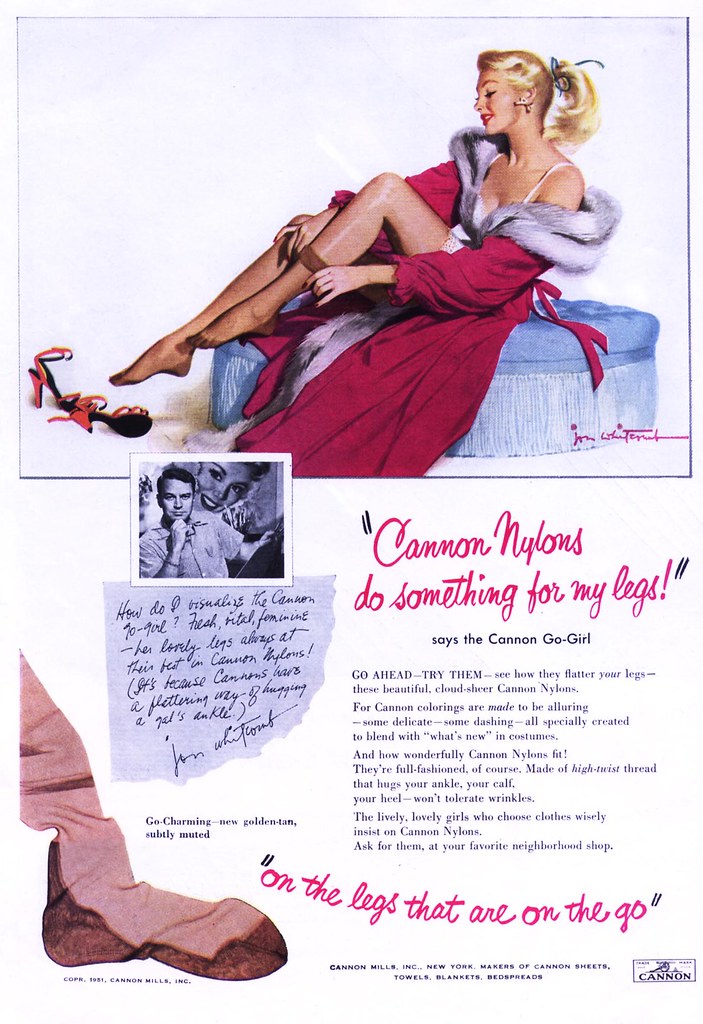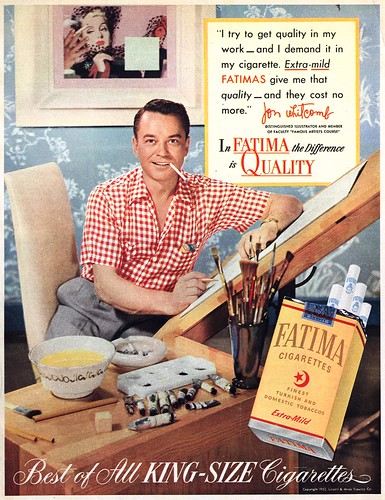
Above is one of four illustrations Robert Fawcett did for a story in that August '54 issue. Its epitomizes the kind of masterful care and attention to detail that was typical of Fawcett's work. No doubt Robert C. Atherton, the art director at Cosmopolitan, was incredibly pleased with this and Fawcett's other three pieces. I'll bet every illustrator, art student and just about anyone else with an appreciation for good illustration marvelled at the skill with which Fawcett executed this piece.
In spite of all that, I doubt Cosmo's mostly female readership gave it much more than a glance.
By contrast is Jon Whitcomb's contribution to that same issue of Cosmopolitan: a four page excerpt from the Famous Artists School course that was one of the lessons Whitcomb provided to the course; "How to Draw a Beautiful Face".

How concisely these two articles describe the work of these two artists!
Compared to Fawcett's moody, elborately detailed and structurally complex story illustration, Whitcomb's article on "how to draw a pretty girl's nose" seems incredibly shallow and facile.
Here's the thing: I'll bet it absolutely captivated it's audience - and probably sold more than few memberships to the Famous Artists Course.

To better facilitate that eventuality, this ad appeared in the same issue as the article.

Both Robert Fawcett and Jon Whitcomb were among the founding faculty of the Famous artists School. Whitcomb was one of the four public faces of the course, along with Norman Rockwell, Albert Dorne, and Al Parker - all of whom appeared in FAS ads regularly placed in most national publications back in the 50's.
I have never come across a single FAS ad featuring Robert Fawcett.
Whitcomb's celebrity extended beyond just his FAS ads. Besides his column in Cosmo, he appeared in several national ad campaigns.

I wonder how frustrating this situation might have been for both artists... Fawcett, with all the respect and admiration of his peers, but lacking the public popularity to attract the kind of wealth and fame that seems to have come so easily to Whitcomb -- and Whitcomb with all the financial success, status and public adoration... but considered a formulaic hack by "the illustrator's illustrator" (whose opinion no doubt carried a lot of weight among the best and most highly placed in the industry).

You know, I can't help but think that in another time and place, say, during the time of Praxiteles, Whitcomb's approach of using a formula for idealised realism, developed over years of study, practice and refinement would have been more than accepted - it would have been celebrated and emulated by every other artist.
Its an interesting example the complexity of the questions: "what is art?", "what is quality?" - and "what is quality art?"
Jon Whitcomb Flickr set
You mention Whitcomb's Famous Artist School pages on how to paint a pretty girl, and they'd make an interesting post all to themselves. He gives the textbook on how to turn an eyebrow, shape a lip, and shade a cheekbone.
ReplyDeleteThe idealized look of the 50's glamour world was established as much by the illustrators as by the movie stars. This might be a good topic for historians and sociologists, too. It's an interesting comment on the zeitgeist of the 50s that people really wanted a single ideal look to aspire to.
Thanks for your comment, James - and you're absolutely correct - if you read through the article, Whitcomb references Hollywoood when he discusses the nuances of what a pretty girl's mouth should look like, or how an eyebrow is shaped, etc.
ReplyDeleteFrom what I've heard and read, a lot of the top illustrators worked and socialized with tv and movie actors... so I guess both groups influenced the style and fashion of the time (along with many other factors, of course).
It's crazy how the idolization of movie stars has changed in some ways and not so much in others.
ReplyDeleteThe pedestal doesn't seem nearly as high and the fall from it not nearly as hard.
Still, I think a lot of illustrators find it easier to reference people of distinction...it's a lot easier if the reference is well known.
Makes you think a bit better of Rockwell, who like John Ford always seemed to cast exceptional characters rather than an idol facade.
Good stuff, Leif!
=shane=
P.S. Sure would like to know what that green square is covering up in that Fatima cigarette ad.
This comment has been removed by a blog administrator.
ReplyDeleteLeif, I am sending this comment using my blackberry in the waiting area of the Atlanta airport because I am traveling on business today and didn't want to wait until I return to weigh in on your great posting. My apologies for any formatting or typo problems.
ReplyDeleteI hadn't thought about it before, but you make an excellent case for Whitcomb and Fawcett as two archetypes with much significance for art in particular and life in general. I would love to see you go even deeper on this. Fawcett was an ardent socialist while Whitcomb was the consummate capitalist. Fawcett was arrogant and did not suffer fools lightly. Whitcomb, as far as I know, was a little vain but otherwise a pretty nice guy. But most importantly, their art reflected two different kinds of success.
You probably wouldn't find a better pair to frame up the issues presented by the difference between quality and success, or even the meaning of success.
Great posting, as always!
I found a Whitcomb original in my garage. Appears to be in good shape. How can I determine if anyone has a special interest in his works.
ReplyDeleteIf by 'special interest' you mean, 'does anybody want to buy it', I would suggest you contact the Illustration House. Their link is in my sidebar.
ReplyDeleteDo you know who the girl is in most of Jon Whitcomb's illustrations (example The Community Silver ones) my mom mailed me an old scrap book she found in an antique store of all these old magazine clippings (circa 1943-1948 mostly) and a friend I discovered that the common link in the pictures seems to be that it is always the same girl. There are several by Jon Whitcomb and Al Parker one by Klett, Michael and several others I can't find a name for also a lucky strike ad. I am wondering if she is actually a model or just a common look that was used for the illustrations? Is the link in this scrapbook the model or is it that the person admired Whitcomb and Parker? I don't know! Help me please!
ReplyDeleteKirsten;
ReplyDeleteBoth Whitcomb and parker used models regularly. That being said, they both understood that there was a formula for that pretty girl 'look' that clients wanted to see. Whitcomb, especially, had a very formulaic approach to his faces.
But if you want to read about some of the models who worked for many of the big illustrators in New York, go to this post about another great 50's artist, Andy Virgil, and no doubt some of the models' names will sound familar to you ( or certainly to your mom):
http://todaysinspiration-andyvirgil.blogspot.com/2007/02/part-4-name-droppings.html
(the section you're after is about half-way down)
I know for sure that Mr. Whitcomb used Phyllis Kirk exclusively for at least a year. She was the California girl
DeleteSusan Hayward, then Edythe Marrenger, was a New York model in her early days and was known to have posed for Whitcomb, John LaGata, Bradshaw Crandall and others. Susan had that turned up nose and wholesome look that Whitcomb liked. And Phyllis Kirk can be recognised over and over in his work.
DeleteQuality art is something made by a person that makes you go 'WOW'(or otherwise affects you emotionally) - that's the art part, and that is executed with a level of skill possessed by only a gifted few - that's the quality part.
ReplyDeleteIt leaves you feeling better off for having experienced it.
I wasn't aware that Fawcett considered Whitcomb a hack. Or aware of any bad blood between them but again, it was so many years ago and a lot of the subtlety of their relationship has
ReplyDeletebeen lost to time. Any quotes from
RF about Whitcomb being well...not
such a good illustrator?
You do Whitcomb a disservice, I own one of his non-famous male portraits, and it has more mood than simple illustration has.
ReplyDelete